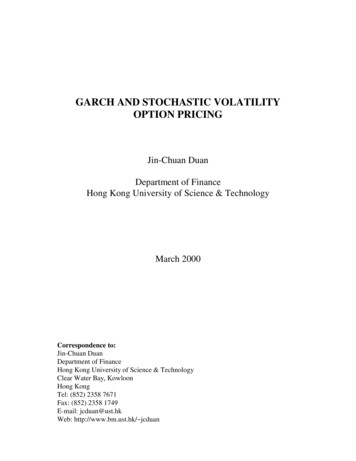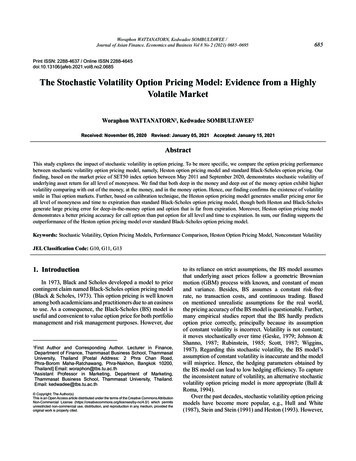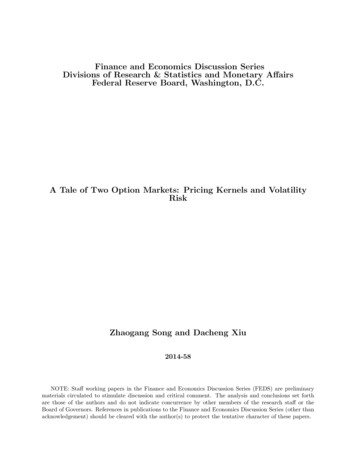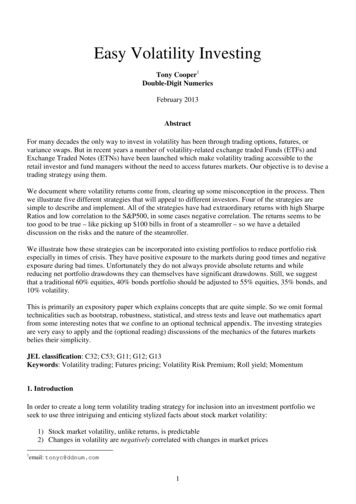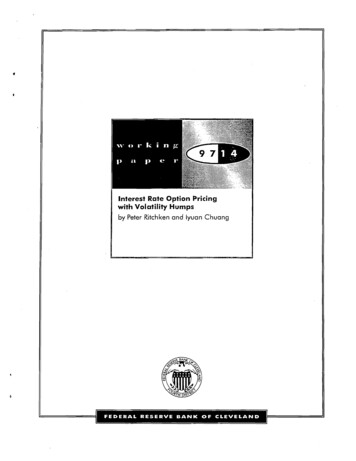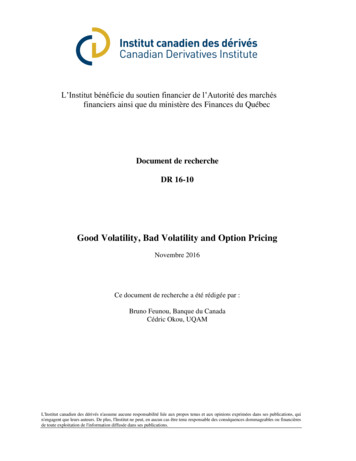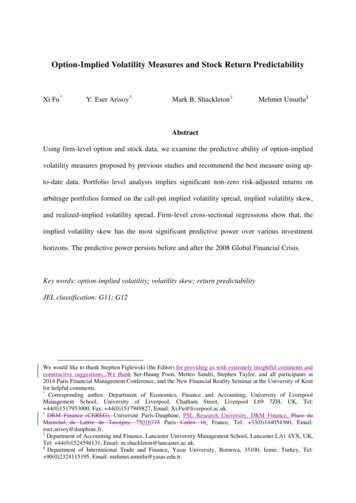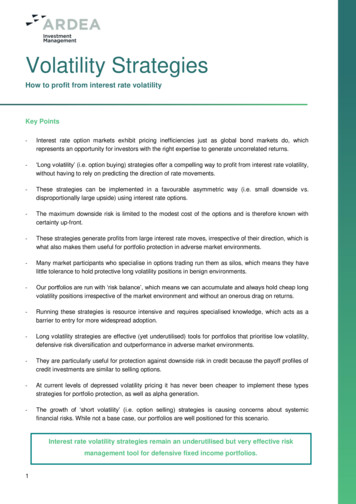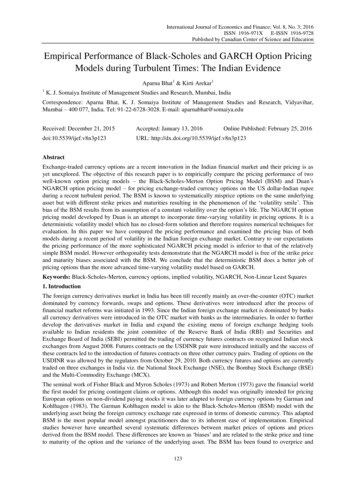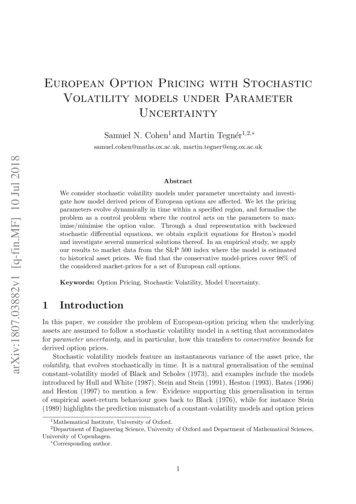
Transcription
IOSR Journal of Business and Management (IOSR-JBM)e-ISSN: 2278-487X, p-ISSN: 2319-7668. Volume 19, Issue 7. Ver. I (July 2017), PP 01-08www.iosrjournals.orgForecasting Volatility and Pricing Option: An EmpiricalEvaluation of Indian Stock MarketSunaina Kanojia1, Neeraj Jain2112DepartmentofCommerce, DelhiSchoolofEconomics, Universityof Delhi, IndiaDepartmentofCommerce, DelhiSchoolofEconomics, Universityof Delhi, IndianAbstract: The present study empirically investigates and examine seven models of volatility forecasting,namely unconditional standard deviation (also written as Long Term Moving Volatility), Standard GARCH(Generalized Autoregressive Conditional Heteroscedasticity) model, GJR-GARCH model, Exponential GARCHmodel (eGARCH), Asymmetric Power GARCH model (apGARCH), Component Standard GARCH model(csGARCH) , and Option Implied Volatility model to gauge the most appropriate model of volatility forecastingin Nifty constituent companies. The assessment of risk and determination of price of the asset class is primarilydependent on the volatility calculated for the class of asset. In view of obtaining precision in the process ofdetermining the price of the option and making hedging most effective, it’s imperative to have the mostappropriate method of calculating the volatility. The present study finds option implied volatility as the bestperforming model except in few categories of option data where VIX outperformed. Similarly on empiricalperformance of Black-Scholes (BS) model the present study finds that performance is not same across variousmaturities which indicate volatility is not constant as assumed by BS model during the tenure of the study inIndian market.Keywords: Black-Scholes model, GARCH Family Models, Standard Deviation, VolatilityI. IntroductionOne of the fundamental issues within finance is the valuation of future returns and the most proximatevaluation of expected return from an asset. While there are various alternatives but a basic paradigm forvaluation, in both academic and in practice, is assumption of competitive market equilibrium: The price that willapply in the market is that price which equates total demand to total supply. The Black-Scholes (1973) [3] wasthe first one who derived the valuation formula for call option rely on the notion of market equilibrium in onlythe weakest possible sense, known as “arbitrage reasoning.” If, under their respective assumptions, the marketprice does not equate to actual price, then market participants would have an opportunity to create an“arbitrage,” that is, to trade securities so as to make unbounded profits with no initial investment and nosubsequent risk of loss. Their valuation approach was based on creating a hedged portfolio whose value iscompletely deterministic over a short span of time (dt). The idea of hedging option with the underlying stockwas first coined by Thorp and Kassouf (1967) [14]. But Black and Scholes found that elimination of risk in thisway leads to restriction on the relationship between the price of an option and the price of the underlying assets.They found, if portfolio is completely hedged (no risk involved), then expected return on the position must bethe riskless interest rate (also as per CAPM). Even though the CAPM does not rely on arbitrage reasoning, italso played a key role in the development of the Black-Scholes formula. Under the assumption that stockfollows Geometric Brownian Motion and using Ito Lemma, Black and Scholes lead to following partialdifferential equation hevolatilityofthestock.Solving the equation subject to boundary conditionc(S,T) max{S K,0}leads to famous B-S formula for call option :-1(2)Corresponding Author. E-mail: neeraj2409@outlook.comDOI: 10.9790/487X-1907010108www.iosrjournals.org1 Page
Forecasting Volatility and Pricing Option: An Empirical Evaluation of Indian Stock strikepriceandτ (T t)isthe maturityofacalloption.Many investors and major corporations use these methods for planning, purchasing, pricing, oraccounting purposes. In addition, to valuing straight put and call options, corporations use Black-Scholesmodeling to value executive stock compensation plans, real production options, warrants, convertible, securities,debt, and so on. (In fact, for many of these applications, the methods are at times applied inappropriately.)BS model is based on many assumptions. Various authors have tested the performance of BS model inthe past. Fischer Black (1972) [2] compared option prices calculated from BS equation with actual marketprices. They observed that “the model tends to overestimate the value of an option on a high variance security;market traders tend to underestimate the value, and similarly, while the model tends to underestimate the valueof an option on a low variance security, market traders tend to overestimate the value” (Fischer Black, 1972, pg416-417). Part of the deviations of the observed market prices from the model prices is thought by Black andScholes, to be due to errors in measurement of the variance of stock returns. The measure of stock returnvariance used in their study was the sample variance of historic stock returns. Black and Scholes found that astrategy of selling options which are overvalued and buying undervalued options could yield substantial profits.However, when they included the transaction cost of trading in options, they found that the implied profits fromthis strategy vanished.MacBeth and Merville (1979) [9] examined daily prices of options on six underlying securities over aone year time period. Their results were exactly opposite to those reported by Black wherein he stated that deepin the money (out of the money) options generally have B-S model prices which are greater (less) than marketprices. They proposed that these conflicting empirical observations may, at least in part, be the result of a nonstationary variance rate in the stochastic process generating stock prices. McBeth and Mervile (1979) [9] alsosuggested trading strategy which involves selling deep in the money options and buying deep out of the moneyoptions. Whether or not this strategy yields abnormally high returns were not tested by Beth and Mervile.Lauterbach and Schultz (1990) [7] examined a sample of over 25,000 daily warrant prices to empiricallyinvestigate potential problems with the commonly used warrant pricing model proposed by Black and Scholesas an extension of their call option model. They found Black- Scholes cause biases in model prices for almost allwarrants and over the entire sample period because of assumption of constant volatility. They further showedthat forecast could be better if constant elasticity of variance is used.II. Relevance Of The StudyAmong all the variables in the BS model, volatility is most crucial variable in the BS model. Unlikeother variables, volatility cannot be observed directly from the market. Therefore, various model has beendeveloped in the past to accurately forecast the volatility and price option accordingly. The present study test theempirical performance of BS model under various volatility models namely, namely Unconditional StandardDeviation (also written as Long Term Moving Volatility), Standard GARCH (Generalized AutoregressiveConditional Heteroscedasticity) model, GJR-GARCH model, Exponential GARCH model (eGARCH),Asymmetric Power GARCH model (apGARCH), Component Standard GARCH model (csGARCH) , andOption Implied Volatility model including Volatility Index (VIX). The present study serve two dual objectives,one to test the empirical performance of BS model under various volatility models, and another to test theperformance of various volatility models (assuming BS model is correctly specified).III. Data Description And Various Input CalculationTo forecast volatility and evaluate the performance of Black-Scholes models, this study used secondarydata of daily closing value of S&P CNX Nifty Index, daily data of Nifty Option contracts, daily closing value ofIndia Volatility Index (VIX), Nifty future prices, and MIBOR. Details about the data given below in the Table 1:Table1: Data ORFrequencyDailyDailyDailyDailyDailyDOI: urnals.orgObservations324214902315515092 Page
Forecasting Volatility and Pricing Option: An Empirical Evaluation of Indian Stock MarketThe data prior to 1st April 2002 is not considered because trading in Nifty future was introduced onJune 4, 2001 and many empirical studies, for example, Raju and Karande (2003)[11], Bandivadekar and Ghosh(2003) [1] and Singh and Kansal (2011)[12] etc. found significant decline in market volatility after theintroduction of derivative product especially future and option contracts.3.1 Input Calculation3.1.1 Exclusion of OutliersFollowing exclusion criteria has been used on the option pricing data.1. Expiry:Only those contracts expiring on the same month or immediate next month have been considered forthe study. This same exclusion criterion is used by NSE on option contracts to calculate VIX. So, toensureconsistency between VIX and other volatility model, all option contracts expiring beyond next immediatemonth have not been considered in this study. Further, contracts having maturity less than 6 days [tradingdays] to maturity are excluded. Short term option contracts are very sensitive to the non-synchronous priceissues and driven by market sentiments.2. Moneyness(m): Option moneyness (m) is defined as ratio of future price of underlying security to optionstrike price.where,is future price of NIFTY at time t of expiry τ years and K is the option strike price. Optioncontracts trading at highly deep in-the-money contains very less information about volatility. Therefore, inthe present study highly deep in-the-money option contractshas not been considered for theempirical investigation. Similarly, option contracts trading at deep-out-money, for, has not beenconsidered for empirical investigation.3. Volume: Options having turnover less than 100 Lacs has not been considered. Again this is done to ensurethat only actively traded option is considered and closing value of index is synchronized with option closingvalue.4. Arbitrage Opportunities: European call option is said to provide arbitrage opportunity, if(4)where,is the option price at time t, F(t, τ) is future price of NIFTY having same maturity as optioncontract, and τ is expiry period. So, option contracts not satisfying arbitrage condition have excluded from thestudy.Based on these criteria only 23155 observations (approximately 3% of original samples) were left foranalysis in the database. The selected observations were divided into several categories according to theirmoneyness and maturity. Various categories on the basis of moneyness and number of observations therein havebeen shown in the Table 2.Table 2: Options categories and number of observationsMoneynessCategory NameDeep out of the money (Deep OTM)OTMNear OTMNear In the Money (ITM)ITMDeep ITMNo. of Observations330845023570336241224291Similarly, on the basis of maturity, contracts have been partitioned into 4 categories: (i) Contractshaving maturity less than or equal to 10 days [trading days], (ii) maturity exceed 10 days but less than or equalto 22 days, (iii) maturity exceed 22 days but less than 34 days, and (iv) maturity more than 34 days. To makemore comprehensive analysis, all the contracts have further been divided on the basis of both moneyness andmaturity. The number of contracts in each subcategory is shown in Table 3.Table3: Number of observations in each sub option categoriesCategoriesm 0.950.95 m 0.980.98 m 1.001.00 m 1.021.02 m 1.051.05 mDOI: 10.9790/487X-1907010108τ 109747166565078160910 τ 228441732137512791502184222 τ 34161116841130104813541471www.iosrjournals.orgτ 347566154003854853693 Page
Forecasting Volatility and Pricing Option: An Empirical Evaluation of Indian Stock Market3.1.2 Strike Price of the OptionThe exercise or the strike price is the price at which the call option contract gets executed. It is well-known byboth the buyer and the seller of the option at the time of entering into the contract.3.1.3 Time to MaturityTime to maturity is the time period left for the expiration of the option contract. It is expressed in ayear. Empirical work suggests that it is trading that cause volatility not the information. Thus, to estimate time tomaturity, we have only considered trading days between option trading date and its expiration date. Not onlyweekend but any other days on which market remain closed is not considered for estimating time to maturity(List of holidays are available on the NSE website and declared in advance).3.1.4 Interest RateBlack-Scholes (BS) model uses risk-free rate of interest as an input to estimate current option price.The BS formula assumes both lending and borrowing is possible at risk- free interest rate. Use of 91 daystreasury rate is primary choice among scholars but it must be noted that borrowing cannot be made at risk-freeinterest rate until and un- less the investor is government itself. Therefore, instead of using T-Bill, we have usedMIBOR as a proxy of interest rate. So, where option maturity is less than 14days [calendar days, not trading] wehave used 14 days MIBOR. Where option maturity is between 15 days to 30days, we have used 30days MIBORrate. 3Months MIBOR is used for Option having maturity more than 30days. Moreover, NSE also uses MIBORrate to calculate VIX index which uses option data. Thus, the use of MIBOR is not only logical choice but alsoconsistent with the VIX.3.1.5 Volatility EstimationVolatility forecasted from various models has been used an input into the BS model. But, before usingas an input, the daily forecasted volatilities are first converted into annualized volatilities. We multiplied thedaily volatility from the square root of number of trading days in a year to get annualized volatility. So,Annualized Volatility Daily Volatility Number of trading days in year(5) Daily Volatility orecastedat(t dyexpressedinannualizedvolatility.3.1.6 Future PriceIn our study, we have used Modified Black-Scholes (BS) model which require Future Price (of NIFTY)to compute option price. Future price is directly observable and can be downloaded from NSE website. Itdoesn’t require any adjustment before using in BS model.IV. MethodologyTo forecast volatility, present study considered seven models, namely Unconditional StandardDeviation (also written as Long Term Moving Volatility), Standard GARCH (Generalized AutoregressiveConditional Heteroscedasticity)(see Bollerslev, 1986) [4] model, GJR-GARCH model (see, Glosten,Jagannathan,andRunkle, 1993) [6], Exponential GARCH model (eGARCH) (see, Nelson, 1991) [10] , Asymmetric PowerGARCH model (apGARCH) (see, Ding,Granger,andEngle, 1993; Taylor, 2012)[5] [13], Component StandardGARCH model (csGARCH) (see, LeeandEngle,1993) [8] , and Option Implied Volatility model (see,BlackandScholes,1973) [3].4.1 Forecasting VolatilityVolatility for NSE Nifty 50 from all models of volatility are forecasted, period from 1st April 2009 to31st March 2015 (Backtesting Period) using in-sample-period (estimation period) of 1st April 2002 to 31stMarch 2009, on rolling basis. It involve re-estimating the parameters of the model as more recent data becomeavailable. The parameters of every GARCH-family models have been updated after every 15 days [trading days]and for historical volatility models parameters are revised for each trading day. For example, first, modelparameters are estimated using in-the-sample data, period from 1st April 2002 to 31st March 2009, thenforecasting is made for next 15 trading days ie from 1st April 2009 to 22nd April 2009 ( include only 15 tradingdays). After that in- the-sample period data is forwarded by 15 trading days from behind (now in-the-sampleperiod span from 22nd April 2002 to 22nd April 2009) and parameters are re-estimated including recentobservations, ensuring that number of observations remain same every time in-the-sample period. Now, againforecasting will be made for next 15 trading days and procedure will be repeated till the entire out-of-sampleDOI: 10.9790/487X-1907010108www.iosrjournals.org4 Page
Forecasting Volatility and Pricing Option: An Empirical Evaluation of Indian Stock Marketperiod is covered. Similar procedure has been followed for every GARCH-Family model for forecastingvolatility.4.2 Performance EvaluationThree loss functions are being used to assess the performance of BS model with different volatility models.1. Root Mean Square Error (RMSE)(6)2. Mean Absolute Error (MAE)(7)3. Mean Absolute Percent Error (MAPE)(8)Where orcalloption.Thehigherthevalueofthestatistics, worstistheperformanceofthemodel.V. Analysis And ResultsThe analysis of the study reveals the mean absolute error, mean absolute percent error, and root meansquare error for difference between actual call option price and model price which is examined to determine themost sought after model to estimate volatility of the option in Indian stock market.5.1 Moneywise PerformanceTable4: Mean Absolute Error by Moneywise for Option IXm 4610.3728118.147730.95 m 258.5508416.876000.98 m 048.1067515.264211.00 m 4.7323358.08664811.5252281.02 m .1424059.8401046.276568m 0910.270235.187941.02 m 690.195626110.035699960.02512093m 06875780.02454940.0122087Table5: Mean Absolute Percent Error by Moneywise for Option IXm 96851230.3620870.68913250.95 m .79249820.18643040.40523970.98 m 95183030.09114110.20313431.00 m .44479790.04813590.0805774Table 4 shows mean absolute error for Black-Scholes (BS) model for different volatility models.Analysis of Table 4 revealed that Mean Absolute Error (MAE) is minimum when implied volatility is used as aninput into the model for option with moneyness less than 1.02. For option with moneyness more than 1.02,MAE is minimum for Volatility Index (VIX). Results show no single model produce minimum MAE for allcategories of option. Long Term Volatility Model (LTMV) is worst model for pricing option as it produceshighest MAE for all categories of option. If moneyness-wise absolute errors are analysed, then, for Deep out-ofmoney (OTM) option (m .95), Implied Volatility leads to minimum error and LTMV model leads tomaximum error by applying the BS model. In the GARCH family models, csGARCH has minimum MAE forDeep OTM but MAE is far away from the IV model. For example, for Deep OTM, MAE for Implied Volatility(IV) model is 10.373 whereas it is 17.8253 for csGARCH. For OTM options (.95 m 0.98), again IV modelis best performer followed by VIX and LTMV model is worst model. For Near ITM and OTM options, again IVDOI: 10.9790/487X-1907010108www.iosrjournals.org5 Page
Forecasting Volatility and Pricing Option: An Empirical Evaluation of Indian Stock Marketmodel is best performer and LTMV model is the worst model. But for option ITM (1.02 m 1.05) and Deepin-the-money (m 1.05), MAE is minimum when VIX is used as an input for volatility in the model. InGARCH family model, MAE is minimum for standard GARCH model for same moneyness but still far awayfrom the best performer. For example, MAE is for Deep in-the-money (m 1.05) for VIX is 5.1879 while it is13.96 by sGARCH.Talking in terms of the percentage errors, shown in Table 5, that Implied Volatility model lead tominimum Mean Absolute Percent Error (MAPE) for all categories of option out-of-money (m 1) and near inthe-money (ITM). But for option ITM (1.02 m 1.05) and deep in-the-money (m 1.05), MAPE is minimumwhen VIX is used as an input for volatility in the model. MAPE gets reduce for all the volatility models asoption moves in the money. For example, MAPE for VIX for options deep out-of-money (OTM) is 68.91%while it reduces to 1.2% for Option Deep ITM. Such consistent improvement in the performance of the modelindicates towards the biasness in the volatility. Empirical studies suggest smile pattern in the volatility ie marketparticipants do not use same volatility for price options having distinct moneyness. Again, LTMV model is theworst performer model. In GARCH family model, csGARCH is best performer for all categories of option outof money (m 1) and near in the money. But for option ITM (1.02 m 1.05) and Deep in the money (m 1.05), MAPE is minimum when sGARCH model is used as an input for volatility in the model. But still, theperformance of GARCH family model are far away from the overall best performer model. For example,MAPE for sGARCH model for option deep ITM is 3.39% while it is 1.2% for best performer model ie VIX.Similarly, MAPE for csGARCH model for option deep OTM is 53.06% (lowest among GARCH family model)while it is 36.21% for IV model (best performer model).Table6: Root Mean Square Error by Moneywise for Option PriceModelm 521.161130.95 m 1115.4918519.273410.98 m 215.5793317.6651.00 m 7414.3795214.155891.02 m .09527216.3868559.537102m .18304816.1583658.493018Similar results were found when Root Mean Square Error (RMSE) is used and exhibited in Table 6.RMSE penalize higher deviations more than smaller deviation. For all categories of OTM options (m 1),RMSE is lower for Implied Volatility (IV) model, while for all categories of option ITM (m 1), RMSE islower for VIX. Again, as option moves in-the-money, RMSE gets reduce for all model of volatility. LTMVmodel is the worst performer model.In conclusion, it seems IV model in absolute and percentage terms is the best input for the BS to priceOTM(m 1) and Near ITM call option, while VIX is best input to price call option ITM(1.02 m 1.05) anddeep in the money(m 1.05). Further, in the absence of VIX, IV model is best performing model. Theperformance of no other model is near to implied volatility.5.2 Maturity Wise PerformanceTable 7 shows the Mean Absolute Error (MAE) for option price for various volatility models. Optionshas been categorized on the basis of maturity. Analysis of results from Table 7 shows that in absolute terms thepricing errors are minimized only when the Implied Volatility (IV) is used as an input into the model for all thematurities. Absolute error increases as maturity increase for all the models.Table7: Mean Absolute Error by Maturity-wise for Option IXτ 388.9851510 τ 6.935949.5541522 τ 12.0366313.73286τ 11.8244017.30963For example, MAE for IV model when maturity is less than 10 is 5.6914 while it increases to 11.824when maturity exceeds 34 days. It shows the ability of the Black-Scholes (BS) model to price near the maturityDOI: 10.9790/487X-1907010108www.iosrjournals.org6 Page
Forecasting Volatility and Pricing Option: An Empirical Evaluation of Indian Stock Marketoption more efficiently than options far away the maturity. As expected, LTMV volatility is the worstperformer. csGARCH is second best model for option having maturity less than 10 days, otherwise, VIX issecond best model for all maturities.Table8: Mean Absolute Percent Error by Maturity-wise for Option IXτ 4001950.10190590.197061410 τ 2222 τ 20.21735150.29171530.96586430.13366250.2465923τ 7787480.13909770.2784894Talking in terms of the percentage errors (results are shown in Table 8), Implied Volatility (IV) modellead to minimum Mean Absolute Percent Error (MAPE) for all categories of option. Again LTMV model isworse performing model. Interestingly, second best model after IV model is csGARCH for all categories ofmaturity. Further, the difference in the performance of various GARCH family model is not quite large. Forexample, MAPE for csGARCH model for options maturity less than 10 days is 14.97% while it is 15.85% forsGARCH model, and 15.55% for gjrGARCh model. Implied volatility performs best even when RMSE is used.Results for RMSE are shown in Table VVIXτ .5527112.5885310 τ 2222 τ 192636.0759969.2537421.535417.32507τ 16.9142621.5012It seems that Implied Volatility (IV) model is the best input for Black-Scholes (BS) model to price calloption for all maturities of option. But each category of maturity has mixture of option with varying moneyness.As we have seen in the results of previous section, IV model performed best only for option out-of-money andnear in-the-money (ITM) options, whereas, Volatility Index (VIX) was the best performer for pricing ITM (1.02 m 1.05) and deep ITM (m 1.05) option.VI. ConclusionThe present study finds option implied volatility as the best performing model except in few categoriesof option data where VIX outperformed. Among GARCH family models only, there is not a single model whichconsistently leads to minimized percentage and absolute error for all categories of option. Component sGARCHmodel is the best model for pricing either out-of-money option or near ITM option, whereas, sGARCH is bestperforming model for pricing option out of money. Overall, no single model perform best for all categories ofoptions. Results found long term moving volatility (an unconditional measure of volatility), most widely usedmeasure of volatility, as a worst model among all category of models. These results are consistent with the paststudies that favour implied volatility for pricing option rather than GARCH derived volatility. The effectivenessof hedging primarily depend on accuracy of volatility forecasting. Therefore, the study recommend the use ofimplied volatility to hedge market risk effectively. The use of implied volatility also serve another advantage. Itdoes not require the entire past history of option data to forecast volatility unlike GARCH models. It is pertinentto note that applying the best performing model to forecast volatility and thereafter pricing leads to closeapproximation of value of underlying asset which is worthy to be followed by both investors and institutionsinvolved in financial markets. Empirical performance of BS models found that performance is not same acrossvarious maturities that indicate volatility is not constant as assumed by BS model. Further, results showsystemic decline in MAE and MAPE for all volatility model as option moves into the money and as maturitydecrease. This shows BS model is more efficient in estimating price of options which are near at-the-money andDOI: 10.9790/487X-1907010108www.iosrjournals.org7 Page
Forecasting Volatility and Pricing Option: An Empirical Evaluation of Indian Stock Marketnear the maturity. In this way, present study provide rationale for using more advanced model for pricingoptions and cautious to the investors who use BS model to price 11][12][13][14]S. Bandivadekar and S. Ghosh, Derivatives and volatility on Indian stock markets, Reserve Bank of India Occasional Papers, 24(3),2003, 187–201.F. Black and M. Scholes, the Valuation of Option Contracts and a Test of Market Efficiency, The Journal of Finance, 27(2), 1972,399–417.F. Black and M. Scholes, The pricing of options and corporate liabilities, The journal of political economy, 1973, 637–654.T. Bollerslev, Generalized autoregressive conditional heteroscedasticity, Journal of econometrics, 31(3), 1986, 307–327.Z. Ding, C. W. Granger, and R.F. Engle, A long memory property of stock market returns and a new model,Journal of empiricalfinance, 1(1), 1993, 83–106.L.R. Glosten, R. Jagannathan, and D.E. Runkle, On the relation between the expected value and the volatility of the nominal excessreturn on stocks, The journal of finance, 48(5), 1993, 1779–1801.B. Lauterbach, and P. Schultz, Pricing Warrants: An Empirical Study of the Black-Scholes Model and Its Alternatives,The Journalof Finance, 45(4),1990, 1181– 1209.G. Lee and R.F. Engle, A permanent and transitory component model of stock return volatility, 1993, Available
dependent on the volatility calculated for the class of asset. In view of obtaining precision in the process of determining the price of the option and making hedging most effective, it's imperative to have the most appropriate method of calculating the volatility. The present study finds option implied volatility as the best
